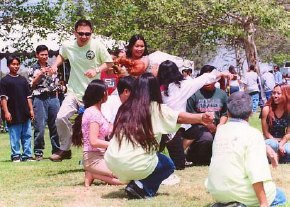Leak Konsaeng (Hiding the Scarf) (  )
)
This is the most popular game of all the traditional games. It can be played not just during the big festival such as Khmer New year but at any time when teenagers get together. This game is also played by adults especially during the New Year. [VANN04]
This game uses a scarf that is twisted on each end in opposite directions then folded in half to form a twisted rope. The ends are tied together as a knot to hold the twisted scarf. The end knot is served as a tail used for gripping and swinging by players. Players can swing to hit another player typically from the waist down as agreed by the team.
In this game all of the players will sit down on the ground facing the center of the circle. The number of players in this game can be five players or more. With more players, the circle becomes bigger to accommodate the seating. Boys and girls usually sit in alternate positions. When forming the circle the players cannot leave a big gap between each other.
There are two styles of play that I am aware of. The first style is the one that I usually play.
Style 1
Initially, the team will choose a person, called the hider to hide the scarf.
- The hider starts off by walking outside the circle holding the scarf behind his/her back in a counter clockwise direction. As the hider walks around, he/she will sing the Leak Konsaeng song while the people sitting down clap their hands and sing at the same time. The wordings are "Leak Kkonsaeng Chma Kham Kaeng OsLorng OsLogn" (
 ) (hiding the scarf, the cat bites the angle, dragging your feet away). This song repeats until the hider sits down. Before the hider sits down, he/she would have dropped the scarf behind another player's back in a concealed way. Then the hider finishes his/her last round around the circle and proceed to sit down at his/her original place.
) (hiding the scarf, the cat bites the angle, dragging your feet away). This song repeats until the hider sits down. Before the hider sits down, he/she would have dropped the scarf behind another player's back in a concealed way. Then the hider finishes his/her last round around the circle and proceed to sit down at his/her original place.
- When the hider sist down or no longer holds the scarf, this signals that the hider already dropped the scarf behind another player. At this point, every player should use their hands to check behind their back for the scarf without looking. The player with the scarf is called the hitter. The hitter will pick up the scarf and proceed to hit the next player to the right.
- The player to the right of the hitter will run around the circle in the counter clockwise direction until finding his/her original seat and sit down. While this person is running around the circle, the hitter can run after this person and hit repeatedly until this person sits down.
- If the hitter does not discover the scarf quick enough, a player to the left of the hitter can pick up the scarf and become the hitter and start hitting the intended hitter.
- Now the person who holds the scarf will become the hider and repeat step one again.
This cycle continues until the team decides to quit.
Style 2
In style 2, the hitter is identified differently.
- This step is the same as step one in style 1.
- After the hider drops the scarf behind the back of a player and the player does not discover the scarf, the hider will continue walking the entire circle back to the player. Then the hider can pick up the scarf and hit the player. The player will now get up and run around the circle and comes back to sit down in the original position.
- If the player discovers the scarf behind his/her back, the player can pick it up and start hitting the hider until the hider sits down at the player's original spot.
- Now the person with the scarf can begin step 1 again.
The game continues until the team decides to quit.
In the second style, the hider can go around the circle in any direction and can even switch back and forth while trying to drop off the scarf. In style 1, the direction is uniform and should be agreed upon in the beginning.
The main distinction between these two styles is that in style 1, the player can choose to sit to the left of another player whom he/she chooses to hit before the game begins. While in style 2, the hider can choose to drop off the scarf behind any player.
Next: Donderm Sluk Chaue >>
(
Teagn Prot
)
